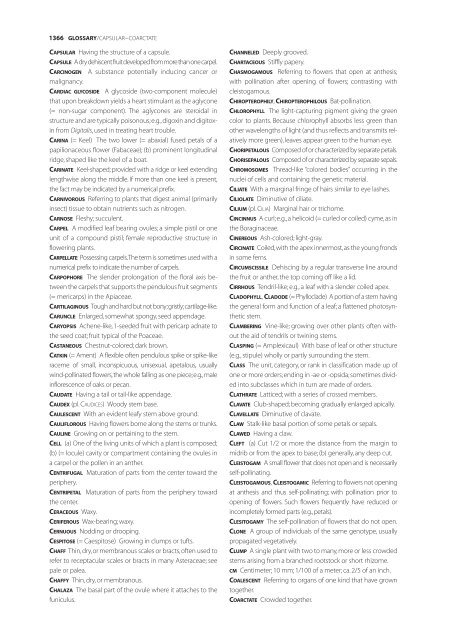Appendices & Glossary - Botanical Research Institute of Texas
Appendices & Glossary - Botanical Research Institute of Texas
Appendices & Glossary - Botanical Research Institute of Texas
Create successful ePaper yourself
Turn your PDF publications into a flip-book with our unique Google optimized e-Paper software.
1366 GLOSSARY/CAPSULAR–COARCTATE<br />
CAPSULAR Having the structure <strong>of</strong> a capsule.<br />
CAPSULE A dry dehiscent fruit developed from more than one carpel.<br />
CARCINOGEN A substance potentially inducing cancer or<br />
malignancy.<br />
CARDIAC GLYCOSIDE A glycoside (two-component molecule)<br />
that upon breakdown yields a heart stimulant as the aglycone<br />
(= non-sugar component). The aglycones are steroidal in<br />
structure and are typically poisonous;e.g.,digoxin and digitoxin<br />
from Digitalis,used in treating heart trouble.<br />
CARINA (= Keel) The two lower (= abaxial) fused petals <strong>of</strong> a<br />
papilionaceous flower (Fabaceae); (b) prominent longitudinal<br />
ridge, shaped like the keel <strong>of</strong> a boat.<br />
CARINATE Keel-shaped; provided with a ridge or keel extending<br />
lengthwise along the middle. If more than one keel is present,<br />
the fact may be indicated by a numerical prefix.<br />
CARNIVOROUS Referring to plants that digest animal (primarily<br />
insect) tissue to obtain nutrients such as nitrogen.<br />
CARNOSE Fleshy; succulent.<br />
CARPEL A modified leaf bearing ovules; a simple pistil or one<br />
unit <strong>of</strong> a compound pistil; female reproductive structure in<br />
flowering plants.<br />
CARPELLATE Possessing carpels.The term is sometimes used with a<br />
numerical prefix to indicate the number <strong>of</strong> carpels.<br />
CARPOPHORE The slender prolongation <strong>of</strong> the floral axis between<br />
the carpels that supports the pendulous fruit segments<br />
(= mericarps) in the Apiaceae.<br />
CARTILAGINOUS Tough and hard but not bony;gristly;cartilage-like.<br />
CARUNCLE Enlarged, somewhat spongy, seed appendage.<br />
CARYOPSIS Achene-like, 1-seeded fruit with pericarp adnate to<br />
the seed coat; fruit typical <strong>of</strong> the Poaceae.<br />
CASTANEOUS Chestnut-colored; dark brown.<br />
CATKIN (= Ament) A flexible <strong>of</strong>ten pendulous spike or spike-like<br />
raceme <strong>of</strong> small, inconspicuous, unisexual, apetalous, usually<br />
wind-pollinated flowers,the whole falling as one piece;e.g.,male<br />
inflorescence <strong>of</strong> oaks or pecan.<br />
CAUDATE Having a tail or tail-like appendage.<br />
CAUDEX (pl. CAUDICES) Woody stem base.<br />
CAULESCENT With an evident leafy stem above ground.<br />
CAULIFLOROUS Having flowers borne along the stems or trunks.<br />
CAULINE Growing on or pertaining to the stem.<br />
CELL (a) One <strong>of</strong> the living units <strong>of</strong> which a plant is composed;<br />
(b) (= locule) cavity or compartment containing the ovules in<br />
a carpel or the pollen in an anther.<br />
CENTRIFUGAL Maturation <strong>of</strong> parts from the center toward the<br />
periphery.<br />
CENTRIPETAL Maturation <strong>of</strong> parts from the periphery toward<br />
the center.<br />
CERACEOUS Waxy.<br />
CERIFEROUS Wax-bearing; waxy.<br />
CERNUOUS Nodding or drooping.<br />
CESPITOSE (= Caespitose) Growing in clumps or tufts.<br />
CHAFF Thin,dry,or membranous scales or bracts,<strong>of</strong>ten used to<br />
refer to receptacular scales or bracts in many Asteraceae; see<br />
pale or palea.<br />
CHAFFY Thin, dry, or membranous.<br />
CHALAZA The basal part <strong>of</strong> the ovule where it attaches to the<br />
funiculus.<br />
CHANNELED Deeply grooved.<br />
CHARTACEOUS Stiffly papery.<br />
CHASMOGAMOUS Referring to flowers that open at anthesis;<br />
with pollination after opening <strong>of</strong> flowers; contrasting with<br />
cleistogamous.<br />
CHIROPTEROPHILY, CHIROPTEROPHILOUS Bat-pollination.<br />
CHLOROPHYLL The light-capturing pigment giving the green<br />
color to plants. Because chlorophyll absorbs less green than<br />
other wavelengths <strong>of</strong> light (and thus reflects and transmits relatively<br />
more green), leaves appear green to the human eye.<br />
CHORIPETALOUS Composed <strong>of</strong> or characterized by separate petals.<br />
CHORISEPALOUS Composed <strong>of</strong> or characterized by separate sepals.<br />
CHROMOSOMES Thread-like “colored bodies” occurring in the<br />
nuclei <strong>of</strong> cells and containing the genetic material.<br />
CILIATE With a marginal fringe <strong>of</strong> hairs similar to eye lashes.<br />
CILIOLATE Diminutive <strong>of</strong> ciliate.<br />
CILIUM (pl. CILIA) Marginal hair or trichome.<br />
CINCINNUS A curl; e.g., a helicoid (= curled or coiled) cyme, as in<br />
the Boraginaceae.<br />
CINEREOUS Ash-colored; light-gray.<br />
CIRCINATE Coiled,with the apex innermost,as the young fronds<br />
in some ferns.<br />
CIRCUMSCISSILE Dehiscing by a regular transverse line around<br />
the fruit or anther, the top coming <strong>of</strong>f like a lid.<br />
CIRRHOUS Tendril-like; e.g., a leaf with a slender coiled apex.<br />
CLADOPHYLL, CLADODE (= Phylloclade) A portion <strong>of</strong> a stem having<br />
the general form and function <strong>of</strong> a leaf; a flattened photosynthetic<br />
stem.<br />
CLAMBERING Vine-like; growing over other plants <strong>of</strong>ten without<br />
the aid <strong>of</strong> tendrils or twining stems.<br />
CLASPING (= Amplexicaul) With base <strong>of</strong> leaf or other structure<br />
(e.g., stipule) wholly or partly surrounding the stem.<br />
CLASS The unit, category, or rank in classification made up <strong>of</strong><br />
one or more orders;ending in -ae or -opsida;sometimes divided<br />
into subclasses which in turn are made <strong>of</strong> orders.<br />
CLATHRATE Latticed; with a series <strong>of</strong> crossed members.<br />
CLAVATE Club-shaped; becoming gradually enlarged apically.<br />
CLAVELLATE Diminutive <strong>of</strong> clavate.<br />
CLAW Stalk-like basal portion <strong>of</strong> some petals or sepals.<br />
CLAWED Having a claw.<br />
CLEFT (a) Cut 1/2 or more the distance from the margin to<br />
midrib or from the apex to base; (b) generally, any deep cut.<br />
CLEISTOGAM A small flower that does not open and is necessarily<br />
self-pollinating.<br />
CLEISTOGAMOUS, CLEISTOGAMIC Referring to flowers not opening<br />
at anthesis and thus self-pollinating; with pollination prior to<br />
opening <strong>of</strong> flowers. Such flowers frequently have reduced or<br />
incompletely formed parts (e.g., petals).<br />
CLESITOGAMY The self-pollination <strong>of</strong> flowers that do not open.<br />
CLONE A group <strong>of</strong> individuals <strong>of</strong> the same genotype, usually<br />
propagated vegetatively.<br />
CLUMP A single plant with two to many, more or less crowded<br />
stems arising from a branched rootstock or short rhizome.<br />
CM Centimeter; 10 mm; 1/100 <strong>of</strong> a meter; ca. 2/5 <strong>of</strong> an inch.<br />
COALESCENT Referring to organs <strong>of</strong> one kind that have grown<br />
together.<br />
COARCTATE Crowded together.
















